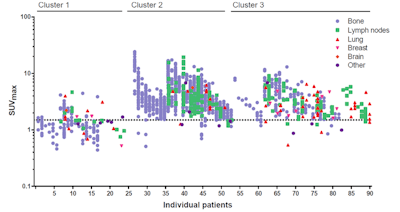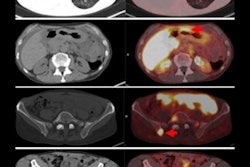
By identifying differences in estrogen receptor (ER) expression through PET imaging with the tracer F-18 fluoroestradiol (FES), clinicians can better direct treatment for patients with metastatic breast cancer, according to a Dutch study published in the August issue of the Journal of Nuclear Medicine.
Among 91 subjects with metastatic breast cancer, FES-PET images revealed that approximately half had one or more ER-negative lesions, while the primary tumor was ER-positive. Knowledge of this difference is seen as the key factor in determining how to approach a patient's treatment (JNM, Vol. 59:8, pp. 1212-1218).
"We concluded that F-18 FES uptake in both tumor and normal tissue uptake is heterogeneous and influenced by the site of metastasis," said senior author Dr. Geke Hospers, PhD, from the University of Groningen in a statement. "This heterogeneity of estrogen receptor expression is, therefore, really common, and it likely affects treatment outcome."
The prognosis and treatment of metastatic breast cancer are greatly influenced by estrogen receptor expression of the metastases. However, information on ER expression across metastases throughout the body and surrounding normal tissue is limited, the authors noted.
For the current study, lead author Dr. Hilde Nienhuis and colleagues used FES-PET/CT to detect a total of 1,617 metastases and normal tissue estrogen receptor expression in 91 patients with ER-positive metastatic breast cancer from November 2009 to December 2014. Each patient received an FES dose of approximately 200 MBq. Lesions with a maximum standardized uptake value (SUVmax) of 1.5 or more were considered ER-positive.
Metastases were found in bone (78%), lymph node (15%), lung (4%), or liver (2%) and were identified most often by PET alone (57%), followed by PET/CT (32%) or CT alone (11%).
By using cluster analysis on the imaging characteristics and metastatic site, the researchers discovered three distinct patterns of patients with ER-positive metastatic breast cancer.
Further investigation revealed significantly higher FES uptake in bone metastases (mean SUVmax, 2.61), compared with lymph nodes (2.29, p < 0.001) and lung metastases (2.23, p = 0.021). In addition, background SUVmax varied among each organ (range: 0.7-3.3), with the greatest amount of uptake in the bones.
 FES distribution and uptake in 1,617 metastases in 91 patients for bone (blue), lymph node (green), lung (red), breast (pink), brain (orange), and other (purple) lesions. Patients are categorized based on subgroups derived from the cluster analysis. Image courtesy of Dr. Hilde Nienhuis et al and JNM.
FES distribution and uptake in 1,617 metastases in 91 patients for bone (blue), lymph node (green), lung (red), breast (pink), brain (orange), and other (purple) lesions. Patients are categorized based on subgroups derived from the cluster analysis. Image courtesy of Dr. Hilde Nienhuis et al and JNM.Thus, the researchers detected differences between FES uptake in tumors and between patients, "underlining the heterogeneous character of breast cancer metastases in ER expression," they wrote. "Moreover, this approach better identifies F-18 FES-negative lesions."
The knowledge of this heterogeneity by means of FES-PET may support future treatment of metastases, Hospers suggested.
"For example, one estrogen receptor-negative lesion could be treated by radiotherapy, while the endocrine treatment is continued for the other estrogen receptor-positive lesions," she said.




















